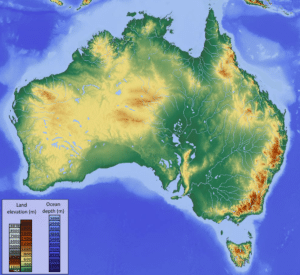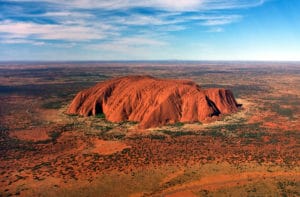
The Great Barrier Reef, the world’s largest coral reef, lies a short distance off the north-east coast and extends for over 1,240 miles. Mount Augustus, claimed to be the world’s largest monolith, is located in Western Australia. At 7,310 feet, Mount Kosciuszko on the Great Dividing Range is the highest mountain on the Australian mainland. Even taller are Mawson Peak (at 9,006 feet, on the remote Australian external territory of Heard Island, and, in the Australian Antarctic Territory, Mount McClintock and Mount Menzies, at 11,457 feet and 11,007 feet respectively.
Australia’s size gives it a wide variety of landscapes, with tropical rainforests in the north-east, mountain ranges in the south-east, south-west and east, and dry desert in the center. The desert or semi-arid land commonly known as the outback makes up by far the largest portion of land. Australia is the driest inhabited continent; its annual rainfall averaged over continental area is less than 500 mm. The population density, 2.8 inhabitants per square kilometer, is among the lowest in the world, although a large proportion of the population lives along the temperate south-eastern coastline.

Eastern Australia is marked by the Great Dividing Range, which runs parallel to the coast of Queensland, New South Wales and much of Victoria. The name is not strictly accurate, because parts of the range consist of low hills, and the highlands are typically no more than 5,249 feet in height. The coastal uplands and a belt of Brigalow grasslands lie between the coast and the mountains, while inland of the dividing range are large areas of grassland. These include the western plains of New South Wales, and the Einasleigh Uplands, Barkly Tableland, and Mulga Lands of inland Queensland. The northernmost point of the east coast is the tropical-rainforested Cape York Peninsula.

The landscapes of the Top End and the Gulf Country — with their tropical climate — include forest, woodland, wetland, grassland, rainforest and desert. At the north-west corner of the continent are the sandstone cliffs and gorges of The Kimberley, and below that the Pilbara. To the south of these and inland, lie more areas of grassland: the Ord Victoria Plain and the Western Australian Mulga shrublands. At the heart of the country are the uplands of central Australia. Prominent features of the center and south include Uluru (also known as Ayers Rock), the famous sandstone monolith, and the inland Simpson, Tirari and Sturt Stony, Gibson, Great Sandy, Tanami, and Great Victoria deserts, with the famous Nullarbor Plain on the southern coast.

Economy:
A wealthy country, Australia has a market economy, a high GDP per capita, and a relatively low rate of poverty. In terms of average wealth, Australia ranked second in the world after Switzerland from 2013 until 2018. In 2018, Australia overtook Switzerland and become the country with the highest average wealth. Australia’s poverty rate increased from 10.2% to 11.8%, from 2000/01 to 2013. It was identified by the Credit Suisse Research Institute as the nation with the highest median wealth in the world and the second-highest average wealth per adult in 2013.
